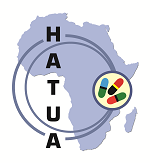Genome Analysis Workshop, April 2021
![]()
Hands-on training in examining whole genomes of UTI-causing bacteria collected from HATUA sites using Galaxy Europe interface and relevant platforms used in bioinformatics.
Learning Outcomes
By the end of the training, you should be able to:
- Examine high-throughput molecular data using tools installed in Galaxy Europe and other relevant platforms.
- Predict AMR content, transmission and evolution within bacterial genomes and apply the principles in HATUA sample collections.
- Reconstruct evolutionary relationships between HATUA genomes of the same species using phylogenetic trees and link these to clinical and other HATUA data types.

| Week | Dates Covered | Concepts | Hands-on |
| 1 | April 26-30 | Introduction to Genome sequencing, Genomics,HATUA. Bacterial genomics: AMR Evolution in bacteria. | Introduction to Galaxy and R/RStudio (swirl); Tools on Galaxy. Galaxy: Read library QC. |
| 2 | May 03-07 | Genome assembly and annotation; AMR Databases. | Read mapping; Assembling a genome from sequence data; Galaxy and Bandage: Annotating genomes with AMR genes and curating a HATUA AMR database; R/RStudio data management. |
| 3 | TBC | Sequence alignment and SNP calling, Phylogenetics and Phylogenomics. | Galaxy and R/RStudio: How to discover and qualify single-nucleotide, copy number and chromosomal mutations; Tools for Comparative genomics and phylogenetics/genomics (Microreact). |
| 4 | TBC | Applications of Genomics to public health research and epidemiology; Linking genomic data to other types of HATUA data. | Data linkage in HATUA; Bonus: Tableau and iTol |
Week 1
- Session 1: Introduction to Genomics and its application to HATUA study
- Session 2: Quick Guide on using Galaxy; Tools on Galaxy
- Session 3: Talk on the Pilot genome data analysis
- Session 4: Read library QC on Galaxy; Launching RStudio (swirl tutorial) on your Desktop and Galaxy
- Session 5: Worksheet instructions
Week 2
- Session 1: Clinical data management in R/RStudio (Guest: Ahmed Raza)
- Session 2: Genome assembly and annotation: Piecing the puzzle together and AMR gene hunting
- Session 3: Assessing Genome Quality using Quast; Viewing genomes on Bandage
- Session 4: Creating and executing workflows on Galaxy
- Session 5: Worksheet instructions
Week 3
- Session 1: Sequence alignment, SNP calling, Phylogenetics/genomics and Pangenomics
- Session 2: Phylogenetic reconstruction and visualisation on Galaxy and Figtree
- Session 3: Epidemiological studies using Microreact
- Session 4: Resolving pandemics using genomics (Guest: Prof. Matt Holden)
- Session 5: Worksheet instructions
Week 4
- Session 1: From the terminal to the clinic (Guest: Martin McHugh)
- Session 2: Holistic data linkage in HATUA (Guest: Dominique Green)
- Session 3: Bonus tools — iTol and Tableau
- Session 4: Poster presentations
Datasets
- HATUA Pilot genomes
- Newly-released HATUA genome samples from MicrobesNG
- Published WGS datasets
Outputs
- Completed worksheets
- Written summary report
- One-page digital poster
Abbreviations
AMR: Antimicrobial resistance
UTI: Urinary tract infection/s
QC: Quality control
SNP: Single nucleotide polymorphism
